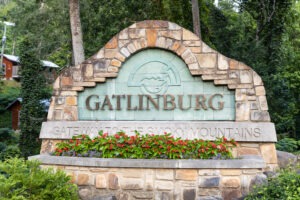How the Power of a Story Can Build a Town
Published on April 7, 2025, at 7:20 p.m.
by Olivia Pickens.
Gatlinburg, Tennessee, has been a tourist hot spot for families, friends and individuals for many years. From exploring the Great Smoky Mountains to whiskey tastings at established distilleries, there is no lack of activities when visiting Gatlinburg.

Caroline Bean is the public relations and communications manager for Gatlinburg Convention and Visitors Bureau. “Gatlinburg really stands out just because it’s the perfect mix of natural beauty,” Bean said. “We’ve got a lot of rich history and all of the attractions. … We have the blend of outdoor adventure, family-friendly attractions, entertainment and then, of course, the deep-rooted Appalachian roots.”
The diverse selection of activities in Gatlinburg makes storytelling a pivotal public relations strategy so each tourist is targeted in a way that will help make the experience more unique and personal. Bean said Gatlinburg CVB places an emphasis on storytelling in each of its campaigns and throughout content. She said its widely popular “Calling All Generations” campaign was inspired by and aligns with Gatlinburg’s iconic tagline, “The Mountains Are Calling.” In addition, its “Memorable Moments” campaign, featuring multiple generations making memories in Gatlinburg, won the MidSouth Regional Emmy Award in 2023.
“A story compels people in a way no other type of messaging can,” Vice President of Fletcher Marketing Communications Sarah Merrell said. “People retain stories.”
Merrell said Fletcher helps clients around the Smokies and in Blount County and the city of Townsend understand the purpose of a person’s trip and what they want to gain from the destination. She noted that it’s the client’s job to help the tourist “achieve that goal” and reach the tourist’s expectations for the trip.

The key to telling a great story lies in the emotion. Bean said authenticity is what makes a story stand out as relatable; user-generated content is becoming an increasingly popular method of capturing those “timeless moments.” The goal is to “bring the destination to life.”
Capturing the local culture and personality can improve potential tourists’ understanding of a destination. Building a connection between locals and visitors creates a greater reason for those visitors to choose that destination over others.
Merrell said another important factor to consider when creating a story is the time of year. She said Fletcher’s work with Blount County Tourism, also known as the Peaceful Side of the Smokies, may push the “romantic getaway” side of the destination around Valentine’s Day or focus on the “family-friendly” destination aspects for Spring Break.
COVID-19 made a large impact on tourism, challenging public relations professionals to find a way to safely promote destinations. Fletcher was able to help the Peaceful Side of the Smokies find business by highlighting outdoor activities that promoted social distancing and cabin rentals that allowed for no contact, as well as noting the drivable distance of Gatlinburg to the majority of the U.S. population.
Fletcher’s work with Blount County Tourism and with cabin and hotel brands in the Gatlinburg and Pigeon Forge areas in the past has added to the growth of tourism in the Great Smoky Mountains as a whole. In fact, Fletcher’s storytelling and ability to relate to visitors helped tourism in the Great Smoky Mountains grow by 20% in the past decade.
The ability to make a destination stick out through a personalized story is what determines the success of a tourism PR campaign. In a recent article, Agility PR Solutions emphasized the importance of creating a memorable experience for travelers. It mentioned augmented reality as one of the newest opportunities for tourism destinations to jump on.
Bean also noted the extreme personalization of a trip that can be created with the help of AI. She can see Gatlinburg’s tourism strategies becoming “more immersive” and tailored to each individual’s trip expectations through AI.
For example, one member of a family may travel to Gatlinburg interested in the moonshine industry, while another member is interested in the outdoors. Personalized travel guides created with the help of AI will help tourists plan their trips with the purpose of meeting everyone’s needs and desires.

Merrell said another tourism PR tactic rising in popularity is media tours. “We can pitch stories out to journalists … but media tours give them the opportunity to come out and actually experience it for themselves,” she explained.
Media tours allow destinations to bring storytelling to a new level. Merrell said there’s a large mix of media outlets, each with its own audience, so each journalist on a media tour will be given an experience that aligns with their target audience.
In addition, Bean noted how her interviews and meetings with media outlets increase awareness of Gatlinburg. Storytelling is pivotal when making these connections. From the way she dresses and presents herself to the topics discussed, storytelling is present from the beginning through the end.
Storytelling is important in every aspect of tourism PR. Merrell said one of the most important keys to effective storytelling is trust. “The audience’s experience has to equal what you fed them,” Merrell said. The story being told must be accurate and align with visitors’ expectations. If the experience does not meet expectations, the trip will not be seen as a success.
Gatlinburg and the Great Smoky Mountain area’s diverse audience and ample opportunities make it a destination everyone can find relatable. The power of storytelling in PR has helped its tourism continue to grow year after year.
“We always say that it’s not the same Gatlinburg your grandparents visited,” Bean said. “It has the same feeling, but there’s been so much growth.”



